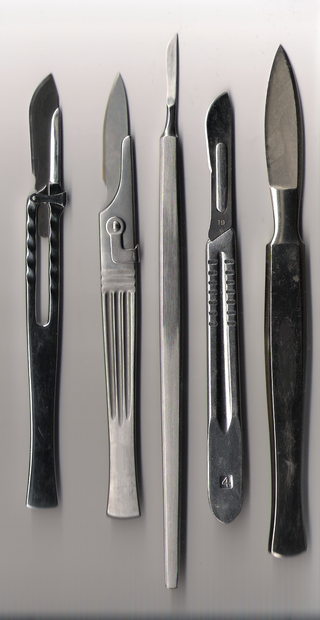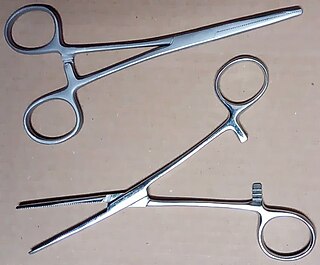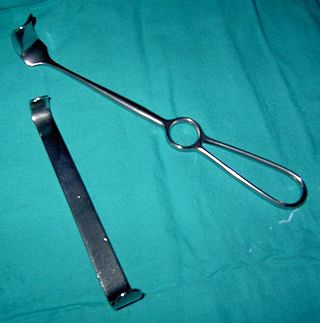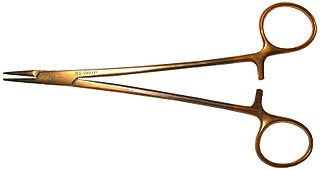
A scalpel, lancet, or bistoury is a small and extremely sharp bladed instrument used for surgery, anatomical dissection, podiatry and various handicrafts. A lancet is a double-edged scalpel.

A hemostat is a tool used to control bleeding during surgery. Similar in design to both pliers and scissors, it is used to clamp exposed blood vessels shut.

Forceps are a handheld, hinged instrument used for grasping and holding objects. Forceps are used when fingers are too large to grasp small objects or when many objects need to be held at one time while the hands are used to perform a task. The term "forceps" is used almost exclusively in the fields of biology and medicine. Outside biology and medicine, people usually refer to forceps as tweezers, tongs, pliers, clips or clamps.
A Pennington clamp, also known as a Duval clamp, is a surgical clamp with a triangular eyelet. Used for grasping tissue, particularly during intestinal and rectal operations. Also used in some OB/GYN procedures, particularly caesarian section. Under the name 'Duval clamp' they are occasionally used much like a Foerster clamp to atraumatically grasp lung tissue. The clamp is named after David Geoffrey Pennington, an Australian surgeon who is a pioneer of microsurgeries.

Blepharoplasty is the plastic surgery operation for correcting defects, deformities, and disfigurations of the eyelids; and for aesthetically modifying the eye region of the face. With the excision and the removal, or the repositioning of excess tissues, such as skin and adipocyte fat, and the reinforcement of the corresponding muscle and tendon tissues, the blepharoplasty procedure resolves functional and cosmetic problems of the periorbita, which is the area from the eyebrow to the upper portion of the cheek. The procedure is more common among women, who accounted for approximately 85% of blepharoplasty procedures in 2014 in the US and 88% of such procedures in the UK.

A retractor is a surgical instrument used to separate the edges of a surgical incision/wound or to hold away certain organs and tissues so that body parts underneath may be accessed during surgical operations.

Electrosurgery is the application of a high-frequency alternating polarity, electrical current to biological tissue as a means to cut, coagulate, desiccate, or fulgurate tissue. Its benefits include the ability to make precise cuts with limited blood loss. Electrosurgical devices are frequently used during surgical operations helping to prevent blood loss in hospital operating rooms or in outpatient procedures.

A needle holder, also called needle driver or needle forceps, is a surgical instrument similar to a hemostat, used by doctors and surgeons to hold and push a suturing needle when performing wound closure, ligation and other surgical procedures that require re-anastomosis.

Metzenbaum scissors are surgical scissors designed for cutting delicate tissue and blunt dissection. The scissors come in variable lengths and have a relatively high shank-to-blade ratio. They are constructed of stainless steel and may have tungsten carbide cutting surface inserts. The blades can be curved or straight, and the tips are usually blunt. This is the most common type of scissors used in organ-related operations.

A surgical suture, also known as a stitch or stitches, is a medical device used to hold body tissues together and approximate wound edges after an injury or surgery. Application generally involves using a needle with an attached length of thread. There are numerous types of suture which differ by needle shape and size as well as thread material and characteristics. Selection of surgical suture should be determined by the characteristics and location of the wound or the specific body tissues being approximated.

The following is a list of instruments that are used in modern obstetrics and gynaecology.
Alfred Washington Adson was an American physician, military officer, and surgeon. He was in medical practice with the Mayo Clinic and the Mayo Graduate School of Medicine of the University of Minnesota at Rochester, Minnesota. He was associated with the development of the Section of Neurological Surgery which was first established at Mayo in 1919. He functioned as its chair until 1946. He undertook pioneering neurosurgery and gave his name to a medical condition, a medical sign, a medical diagnostic manoeuvre, and medical instruments.
Surgical scissors are scissors specially manufactured as surgical instruments, typically used for cutting sutures, dressings, and cutting and dissecting biological tissue. Surgical scissors are usually made of surgical steel. Some have tungsten carbide reinforcements along their cutting edges, the hardness of which allows manufacturers to create sharper and more durable edges.

Mayo scissors are a type of surgical scissor, often used in the cutting of fascia.

Circumcision surgical procedure in males involves either a conventional "cut and stitch" surgical procedure or use of a circumcision instrument or device. In the newborn period, almost all circumcisions are done by generalist practitioners using one of three surgical instruments. In the US, the Gomco clamp is the most utilized instrument, followed by the Mogen clamp and the Plastibell. They are also used worldwide.
No-scalpel vasectomy is a type of vasectomy procedure in which a specifically designed ringed clamp and dissecting hemostat is used to puncture the scrotum to access the vas deferens. This is different from a conventional or incisional vasectomy where the scrotal opening is made with a scalpel. The NSV approach offers several benefits, including lower risk for bleeding, bruising, infection, and pain. The NSV approach also has a shorter procedure time than the conventional scalpel incision technique. Both approaches to vasectomy are equally effective. Because of the inherent simplicity of the procedure it affords itself to be used in public health programs worldwide. This method is used in over 40 countries for male sterilisation.
Dural tear is a tear occurring in the dura mater of the brain. It is usually caused as a result of trauma or as a complication following surgery.
An invasive test is a type of medical procedure that requires trained medical providers to use instruments that cut skin or that are inserted into a body opening. Examples of invasive tests include biopsy, excision, cryotherapy, and endoscopy.

Ancient Roman surgical practices developed from Greek techniques. Roman surgeons and doctors usually learned through apprenticeships or studying. Ancient Roman doctors such as Galen and Celsus described Roman surgical techniques in their medical literature, such as De Medicina. These methods encompassed modern oral surgery, cosmetic surgery, sutures, ligatures, amputations, tonsillectomies, mastectomies, cataract surgeries, lithotomies, hernia repair, gynecology, neurosurgery, and others. Surgery was a rare practice, as it was dangerous and often had fatal results. To perform these procedures, they used tools such as specula, catheters, enemas, bone levers, osteotomes, phlebotomes, probes, curettes, bone drills, bone forceps, cupping vessels, knives, scalpels, scissors, and spathas.



















